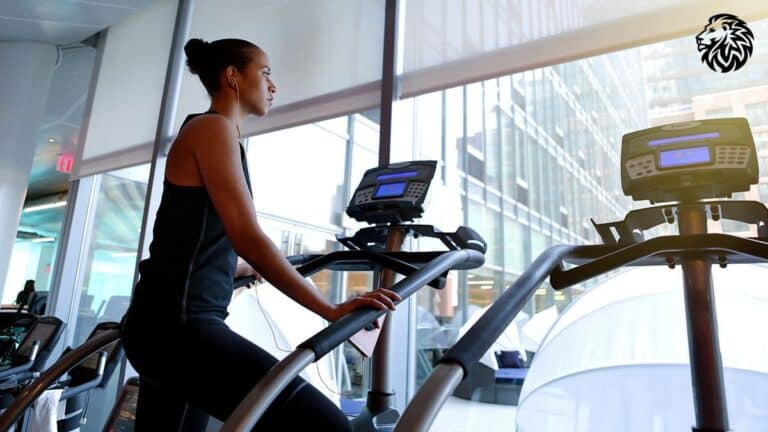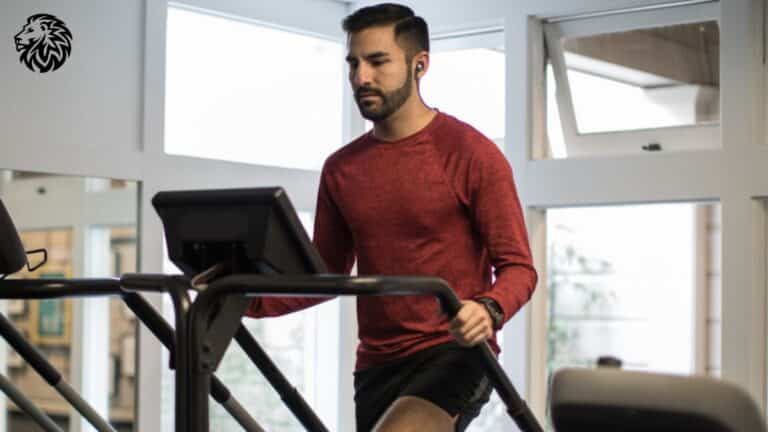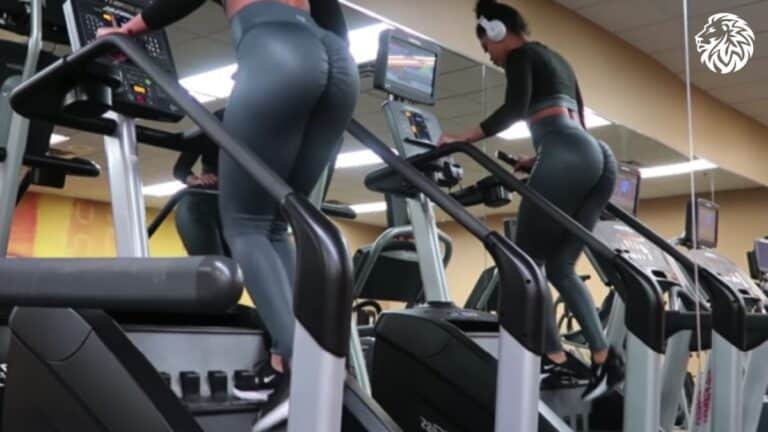When it comes to efficient and effective workouts, the stair climber is often a go-to for fitness enthusiasts and beginners alike. Acting as an escalator that never stops, this machine challenges even the fittest athletes and offers numerous benefits.
The stair climber isn’t just another gym machine; it’s a powerhouse of a cardio workout. By simulating the action of climbing stairs, it targets key muscle groups in the legs such as the quadriceps, hamstrings, calves, and glutes. This repetitive motion not only helps tone and strengthen these muscles but also significantly elevates the heart rate, providing an excellent cardiovascular workout. As one ascends, they’re essentially lifting their body weight with each step, making it far more demanding than flat-surface walking or jogging.
Caloric burn is the essence of weight loss: burn more calories than you consume, and you’ll lose weight. This simple principle underscores the appeal of the stair climber. Due to its high-intensity nature, it has the potential to burn a substantial amount of calories in a shorter period compared to other low-impact exercises. Moreover, a more intense workout like that of the stair climber can lead to a phenomenon known as the “afterburn” effect or excess post-exercise oxygen consumption (EPOC), where the body continues to burn calories at an elevated rate even after the workout is done. Thus, maximizing the calories burnt during a stair climber session not only aids in weight loss but also boosts overall fitness and endurance levels.
Though simply spending time on the stair climber can be beneficial, adopting specific strategies can help users get the most out of their workouts. This article will delve into seven such tactics: from manipulating resistance and incorporating intervals to ensuring proper form and even leveraging the power of music. Each method aims to challenge the body in unique ways, ensuring users get the maximum calorie-burning potential out of every sweat-filled session. So, let’s step up the game and dive deep into these strategies!
1. Increase the Resistance

Adjusting the resistance on a stair climber can transform a moderate workout into a challenging ordeal that not only tests your stamina but also significantly increases your calorie burn.
Explanation of how resistance affects calorie burn.
Resistance plays a pivotal role in determining the intensity of your workout. In the context of a stair climber, resistance dictates how much effort you need to put into each step. The higher the resistance, the more force your muscles must exert to push down the steps, which in turn requires more energy. This energy comes from burning calories, both during the workout and after, due to the increased metabolic rate caused by the intense exercise. High resistance can also shift the workout from predominantly cardio-focused to strength-endurance, engaging your muscles more intensely and thus burning more calories.
Tips for gradually increasing resistance levels.
It’s crucial to approach resistance incrementally, especially if you’re new to using a stair climber:
- Start at a resistance level that allows you to maintain proper form and a steady pace without overstraining.
- As your body adapts and the workouts become less challenging, increase the resistance gradually. A good rule of thumb is to up the resistance by one level every 1-2 weeks, depending on your comfort and fitness level.
- Monitor your heart rate to ensure it’s within your target zone. You should be able to speak a few words, but not hold a full conversation.
- Keep sessions varied – some days can be focused on high resistance, while others can be lighter, allowing your body to recover.
Safety considerations when adjusting resistance.
Safety should always be a priority when adjusting resistance levels:
- Avoid high resistance if it causes you to lean heavily on the handrails or compromises your form. This not only reduces the effectiveness of your workout but can also lead to injuries.
- Listen to your body. If you feel pain (beyond normal muscle fatigue) or if your movement becomes jerky or uncontrolled, reduce the resistance.
- Ensure you warm up adequately before jumping into a high-resistance workout to prepare your muscles and reduce the risk of strains or sprains.
- Consider consulting with a fitness professional to determine the appropriate resistance level for your fitness level and goals.
By thoughtfully increasing resistance and prioritizing safety, you can effectively boost your calorie burn and see better results from your stair climber workouts.
2. Incorporate Intervals

Interval training is a versatile and efficient way to enhance any workout routine, including sessions on the stair climber. It involves alternating between periods of high-intensity effort and low-intensity recovery.
Definition and benefits of interval training.
Interval training is characterized by interspersing short bursts of intense exercise with intervals of lighter activity or rest. This technique has gained immense popularity due to its numerous benefits:
- Efficiency: You can achieve significant health and fitness benefits in a shorter time compared to steady-state workouts.
- Improved Cardiovascular Fitness: High-intensity intervals can improve oxygen and blood flow, strengthening the heart and lungs.
- Increased Caloric Burn: The intense phases of the workout lead to higher calorie expenditure both during and after the session.
- Fat Loss: Interval training is effective in reducing body fat, including visceral fat that surrounds vital organs.
- Enhanced Endurance: It helps in building stamina and muscular endurance over time.
- Variety: Interval training breaks the monotony and can make workouts more engaging and challenging.
Examples of interval routines for the stair climber.
Here are a couple of interval routines that can be applied to a stair climber workout:
- Beginner Interval:
- Warm-up: 5 minutes at a comfortable pace with low resistance.
- Interval: 30 seconds of increased pace (or resistance), followed by 1 minute of slow-paced recovery.
- Repeat the interval 10 times.
- Cool down: 5 minutes at a comfortable pace with low resistance.
- Advanced Interval:
- Warm-up: 5 minutes at a moderate pace.
- Interval: 1 minute of high-intensity effort (increased pace and resistance), followed by 1 minute of moderate-paced recovery.
- Repeat the interval 15-20 times.
- Cool down: 5 minutes at a slower pace.
How interval training boosts metabolism and caloric expenditure.
Interval training elevates the workout’s intensity, which not only burns more calories during the session but also triggers a higher post-exercise oxygen consumption (EPOC). This means your body continues to burn calories at an accelerated rate even after you’ve finished exercising, often referred to as the “afterburn effect.” The intense exertion also promotes muscle adaptation and growth, which in turn raises your resting metabolic rate, allowing you to burn more calories even when you’re not working out. By incorporating interval training into your stair climber routine, you optimize your time spent exercising and significantly boost caloric burn and overall fitness.
3. Utilize Proper Form

Proper form is the cornerstone of any effective workout, ensuring you get the most out of your time on the stair climber while minimizing the risk of injury.
Description of the correct posture and foot placement.
- Posture: Stand tall with your core engaged. Your shoulders should be back and down, not hunched over. Your gaze should be forward, not looking down at your feet, to maintain a neutral neck position.
- Foot Placement: Step onto the center of each pedal with your entire foot, not just the toes. This ensures maximum muscle engagement and reduces strain on your calves and Achilles tendons.
- Arm Movement: If not holding onto the rails, let your arms swing naturally with your strides. If holding onto the rails, use them lightly for balance, not support.
- Breathing: Maintain a steady breathing pattern. Inhale deeply through your nose and exhale through your mouth.
The relationship between form and efficiency in calorie burning.
Proper form is crucial for efficiency in calorie burning for several reasons:
- Muscle Engagement: Correct posture ensures the right muscles are targeted, particularly the glutes, quads, and hamstrings. The more muscle engagement, the higher the calorie burn.
- Energy Expenditure: Good form prevents unnecessary energy wastage. When your body is aligned correctly, each step is more powerful and efficient, meaning more calories are burned.
- Endurance: Proper form reduces fatigue and allows you to work out longer or at a higher intensity, both of which contribute to increased calorie burn.
Common mistakes to avoid.
- Leaning Too Far Forward: This can strain your back and reduce engagement of the lower body muscles.
- Over-Gripping the Handrails: This can shift the effort from your legs to your arms, reducing the effectiveness of the workout.
- Looking Down: This can disrupt your balance and cause neck strain.
- Using Only the Toes: This limits muscle engagement and can cause calf strain.
- Slouching: Poor posture can lead to a less effective workout and potential back pain.
By maintaining proper form on the stair climber, you not only ensure a safer workout but also maximize the caloric burn, getting the most out of every step.
4. Engage Additional Muscle Groups

Turning your stair climber routine into a full-body workout can significantly enhance calorie burn and overall fitness. Here’s how you can involve more than just your lower body.
Techniques to involve the upper body and core (e.g., using the handrails strategically).
- Handrail Pulls: Instead of merely resting your hands on the handrails, actively pull on them as you step. This engages your biceps, back, and shoulders.
- Handrail Pushes: Push down on the handrails with each step to activate your triceps and chest.
- Core Engagement: Actively engage your core muscles as you climb. This not only improves balance but also works your abs and obliques.
- Twists: Add a slight twist at the torso with each step to further engage the core.
The benefits of full-body engagement for calorie burning.
Involving your upper body and core has several benefits:
- Increased Caloric Expenditure: Engaging more muscles requires more energy, thus burning more calories.
- Enhanced Coordination and Balance: Full-body workouts improve overall coordination and balance.
- Muscle Tone and Strength: Working your upper body and core can help tone these muscles, contributing to a more balanced physique.
- Workout Efficiency: You get a more comprehensive workout in the same amount of time, improving overall fitness.
Simple exercises to incorporate without disrupting the stair climbing motion.
- Arm Extensions: Extend your arms out to the side or in front of you as you step. This engages your deltoids and chest.
- Shoulder Shrugs: Raise and lower your shoulders with each step to work your trapezius muscles.
- Knee Lifts: Lift your knee higher than usual on some steps to increase core engagement and mimic a stepping motion.
- Heel Lifts: At the top of each step, lift your heel to engage your calf muscles more intensely.
By incorporating these techniques and exercises into your stair climber routine, you transform a lower-body workout into a full-body challenge, significantly increasing the number of calories burned and enhancing overall strength and endurance.
5. Leverage the Power of Music

Music isn’t just a source of entertainment; it can be a powerful tool to elevate your workout, especially on a stair climber.
The impact of tempo and rhythm on workout intensity.
The tempo and rhythm of music can profoundly impact your workout intensity:
- Pacing: Music with a faster tempo can subconsciously encourage you to match the beat, potentially increasing your pace and intensity.
- Rhythm: Consistent rhythm can help establish a steady pace, making it easier to maintain a certain level of intensity throughout your workout.
- Distraction: Upbeat music can distract from the physical exertion, helping you push through tough parts of your workout.
Creating a playlist to maintain a vigorous pace.
To harness the power of music, consider creating a playlist with the following in mind:
- Warm-Up Songs: Start with songs that have a moderate tempo to ease into the workout.
- High-Intensity Songs: Include tracks with a faster tempo and strong beats for the more intense portions of your workout, such as intervals.
- Cool-Down Songs: Finish with slower, relaxing tunes to help bring your heart rate down and initiate recovery.
Research findings on music and workout performance.
Research has shown that music can have a positive effect on workout performance:
- Increased Endurance: Studies have found that music can increase workout duration by providing a psychological lift.
- Improved Mood: Music can elevate mood, which is linked to improved performance.
- Reduced Perceived Effort: Listening to music can make the workout feel easier, allowing you to push harder and longer.
By strategically incorporating music into your stair climber routine, you can enhance your workout intensity, duration, and enjoyment, leading to more calories burned and a more satisfying exercise experience.
6. Alternate Your Step Pattern

Mixing up your step pattern can inject variety into your stair climber routine, challenge different muscle groups, and prevent plateaus in fitness progress.
Different step patterns and their benefits (e.g., skipping steps, sideways steps).
- Skipping Steps: By skipping a step with each stride, you engage more of your glutes and hamstrings and enhance your range of motion, mimicking a lunging motion.
- Sideways Steps: Turning to the side works your inner and outer thighs more intensively and can improve your lateral movement and stability.
- Double Steps: Taking two steps at a time for a short burst can be a form of interval training, spiking your heart rate and engaging your larger leg muscles.
How varying patterns can prevent muscle adaptation and increase calorie burn.
Varying your step pattern has several advantages:
- Muscle Confusion: Changing the stimulus prevents your muscles from becoming too efficient at a specific movement, which can plateau calorie burn and strength gains.
- Increased Engagement: Different patterns engage different muscle groups or the same muscles in different ways, leading to increased overall muscle recruitment and higher calorie expenditure.
- Mental Engagement: Altering your pattern requires concentration and coordination, keeping your mind engaged and making the time pass more quickly.
Safety tips when trying new step patterns.
While trying new step patterns can be beneficial, it’s important to stay safe:
- Start Slow: When trying a new pattern, start at a slower pace until you’re comfortable with the movement.
- Use Handrails Initially: Until you’re confident with your balance during the new pattern, lightly hold the handrails to prevent falls.
- Maintain Proper Form: Even as you try new patterns, keep your posture upright and core engaged.
- Don’t Overdo It: Incorporate new patterns gradually to avoid overuse injuries.
- Stay Focused: Pay attention to your movements, especially when stepping sideways or skipping steps, to maintain your balance and coordination.
By alternating your step pattern, you not only prevent boredom and muscle adaptation but also enhance calorie burning and overall fitness, making your stair climber workouts more effective and engaging.
7. Combine with Strength Training

Integrating strength training with your stair climber routine can turn it into a comprehensive fitness regimen that boosts calorie burn both during and after your workout.
The concept of circuit training and its caloric benefits.
Circuit training involves rotating through a series of exercises with minimal rest in between. This method can effectively blend cardiovascular exercise and strength training, leading to:
- Increased Caloric Burn: Alternating between high-intensity cardio and strength exercises keeps your heart rate elevated, burning more calories.
- EPOC (Excess Post-exercise Oxygen Consumption): Circuit training can lead to a significant afterburn effect, where your body continues to burn calories at a higher rate after the workout.
- Time Efficiency: You get the benefits of both cardio and strength training in a single session.
Examples of strength exercises to pair with stair climber intervals.
Consider the following strength exercises to complement your stair climber workout:
- Squats or Lunges: They target the same lower body muscles as the stair climber but with added resistance.
- Push-Ups or Dumbbell Presses: These work the upper body, providing balance to the lower body focus of the stair climber.
- Planks or Russian Twists: These core exercises enhance stability and can improve your form on the stair climber.
- Deadlifts: This compound movement engages the back, glutes, and hamstrings, complementing the stair climber’s lower body workout.
The role of muscle mass in boosting resting metabolic rate.
Increasing muscle mass has a direct impact on your resting metabolic rate (RMR):
- Higher Energy Requirements: Muscle tissue burns more calories at rest compared to fat tissue.
- Improved Metabolic Efficiency: As your muscle mass increases, your body becomes more efficient at burning calories, even when you’re not exercising.
- Long-Term Benefits: Building muscle supports a healthy metabolism, making it easier to maintain or lose weight over time.
By incorporating strength training into your stair climber routine, you create a synergistic effect that not only increases your calorie burn during the workout but also builds muscle mass, which can elevate your resting metabolic rate and improve overall body composition.
Conclusion
The stair climber, while a seemingly simple machine, holds immense potential for those looking to boost their fitness and calorie burn. It’s not just about stepping; it’s about how you step, how you engage, and how you challenge yourself.
Recap of the 7 strategies to maximize calorie burn on the stair climber.
- Increase the Resistance: Push yourself a little more by adding resistance, forcing your muscles to work harder.
- Incorporate Intervals: Bring high-intensity bursts into your routine to supercharge your metabolism.
- Utilize Proper Form: Prioritize efficiency and safety by maintaining the right posture and foot placement.
- Engage Additional Muscle Groups: Go beyond the legs by involving the upper body and core for a full-body workout.
- Leverage the Power of Music: Let the rhythms guide and motivate you, pushing you to maintain or even increase your pace.
- Alternate Your Step Pattern: Mix up your steps to challenge different muscles and prevent adaptation.
- Combine with Strength Training: Integrate strength exercises to build muscle, which in turn boosts your resting metabolic rate.
Fitness is a personal journey. What works wonders for one might not resonate with another. It’s essential to take these strategies and tailor them, through experimentation and adjustment, to fit your individual needs, goals, and preferences. Find your rhythm, your challenge, and your joy in the process.
The key to any successful fitness regimen lies in two fundamental principles: consistency and safety. While pushing your boundaries and seeking improvement is commendable, always prioritize your safety to prevent injuries. And remember, consistent efforts, no matter how small, accumulate over time, leading to lasting change and success. Stay committed, stay safe, and let the stair climber be a stepping stone to your fitness aspirations.







